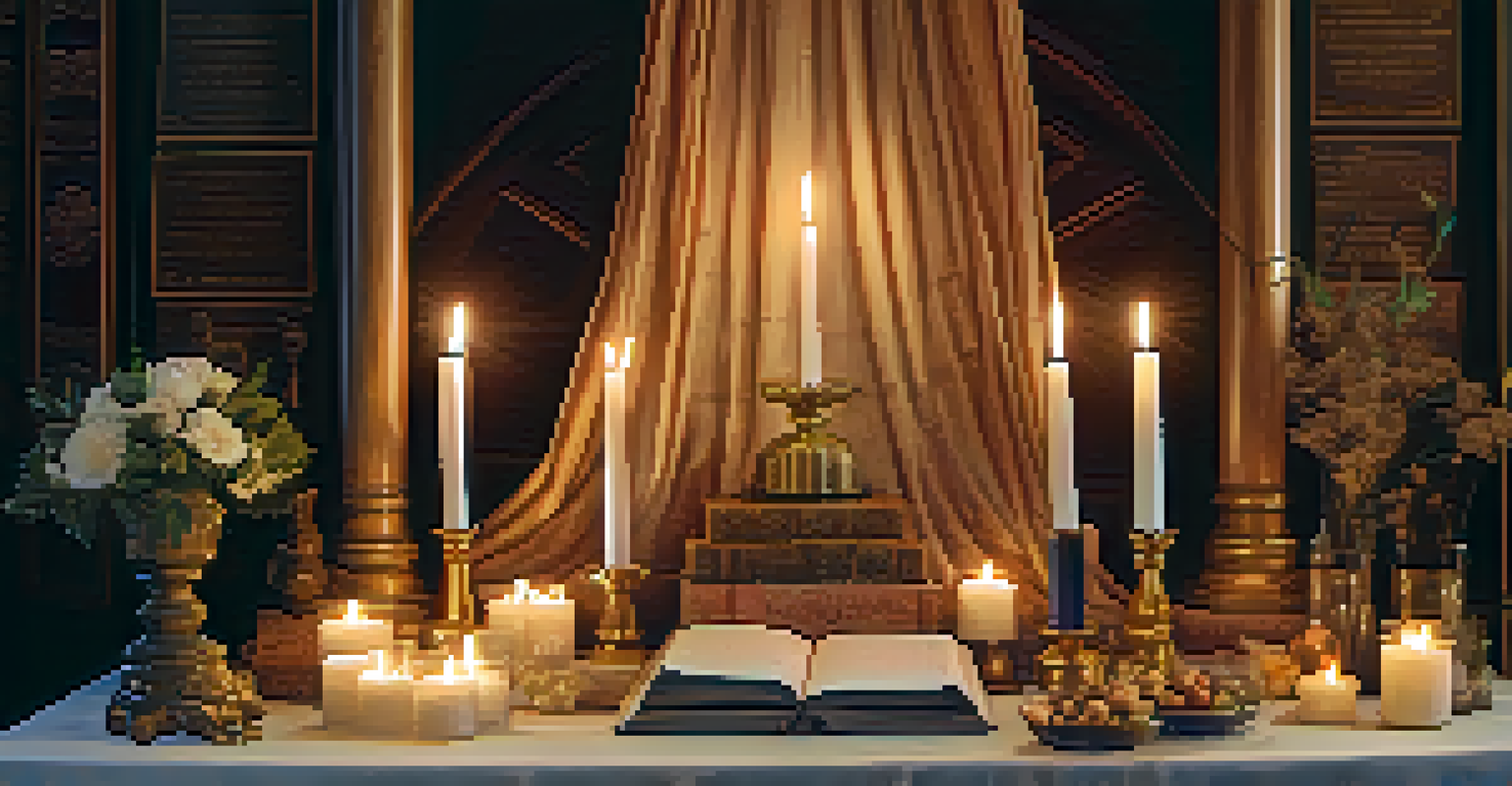Gender Perspectives on Spirituality in Different Cultures

Understanding Spirituality: A Gendered Lens
Spirituality is a deeply personal journey, often influenced by cultural and societal norms. When viewed through a gendered lens, it becomes clear that men and women may experience and express spirituality in distinct ways. For example, women might gravitate towards nurturing practices, while men may lean towards more structured forms of spirituality. This divergence highlights how gender shapes spiritual beliefs and practices.
The divine feminine is not about being a woman, but rather about embracing the qualities that are traditionally associated with femininity, such as nurturing, intuition, and connection.
In many cultures, women's roles in spirituality often involve community-building and caregiving. Think of the women in various indigenous cultures who serve as healers or spiritual guides, fostering connections within their communities. This nurturing aspect is not only vital for the preservation of spiritual traditions but also emphasizes the importance of collective experiences in women’s spiritual journeys.
On the other hand, men may find their spirituality expressed through leadership roles or solitary practices. For instance, male monks in various traditions often embody discipline and introspection, highlighting a contrasting approach to spirituality. Understanding these gendered experiences allows for a richer appreciation of how spirituality manifests differently across genders.
Historical Context: Gender and Spirituality Over Time
Throughout history, the relationship between gender and spirituality has evolved dramatically. In many ancient societies, women held significant spiritual power, often serving as priestesses or oracles. However, as patriarchal structures emerged, these roles were frequently diminished, reflecting broader societal changes. This historical context is crucial for understanding current gender dynamics in spiritual practices.

For example, in early Roman and Greek cultures, women were integral to religious rituals and ceremonies. Yet, as these societies grew more male-dominated, women's contributions became marginalized. This shift didn’t just impact women's spiritual roles; it also altered how communities understood and valued different spiritual expressions.
Gender Shapes Spiritual Experiences
Men and women often express their spirituality differently, influenced by societal norms and cultural roles.
Today, there is a resurgence of interest in reclaiming these historical roles for women in spirituality. Movements aimed at gender equality within spiritual contexts highlight the need to restore balance and recognition for women's contributions. This ongoing dialogue underscores the importance of history in shaping contemporary spiritual landscapes.
Cultural Variations: Gender and Spiritual Practices
Different cultures offer unique perspectives on the interplay between gender and spirituality. In some Indigenous cultures, for example, spiritual practices are often intertwined with gender roles that emphasize the balance between the masculine and feminine. Such beliefs foster a holistic approach to spirituality that values both perspectives equally.
Spirituality is a way of being, a way of seeing the world, that transcends the limitations of gender and invites all to participate in the sacred.
Conversely, in many Western religions, traditional gender roles can create barriers to equal participation in spiritual practices. For instance, women have historically faced restrictions in leadership roles within major religious institutions. This disparity can lead to feelings of disconnection and a search for alternative spiritual avenues that honor women's voices.
However, as societies evolve, many cultures are beginning to embrace more inclusive spiritual practices. Feminist spirituality movements, for instance, seek to create spaces where women can explore their spirituality without the limitations imposed by traditional gender roles. This cultural shift highlights the ongoing negotiation of gender within spiritual contexts.
Modern Movements: Gender Inclusivity in Spirituality
In recent years, there has been a significant push towards gender inclusivity in spiritual practices worldwide. Many spiritual movements now emphasize the importance of both male and female perspectives. This shift reflects a broader societal recognition of the need for diverse voices in spiritual discussions, leading to more balanced practices.
For example, contemporary movements like Women's Spirituality and Queer Spirituality challenge traditional norms, advocating for a more inclusive understanding of spirituality. These movements encourage individuals to explore their spirituality in ways that resonate with their identities, breaking away from rigid gender norms. This opens the door for a richer, more diverse spiritual experience.
Historical Shifts Impact Spiritual Roles
The evolution of gender roles throughout history has significantly altered women's and men's contributions to spirituality.
Moreover, many communities are now actively working to create spaces where all genders can participate equally. Workshops, retreats, and discussions aimed at fostering inclusivity allow for a blend of perspectives that enrich spiritual practices. This modern approach not only enhances individual experiences but also strengthens communal bonds.
The Role of Rituals: Gender Perspectives in Practice
Rituals play a significant role in expressing spirituality, and they often reflect gendered dimensions. In many cultures, rituals are designed to celebrate the unique contributions of different genders. For instance, female-centric rituals may focus on fertility, motherhood, or community bonding, while male-centric rituals might emphasize strength, leadership, or individualism.
These rituals not only reinforce traditional gender roles but also provide a platform for individuals to explore their spirituality. Engaging in gender-specific rituals allows participants to connect with their cultural heritage and express their identities within a spiritual context. This connection can foster a sense of belonging and purpose.
However, as society evolves, so too do these rituals. Many spiritual practices are now adapting to embrace more inclusive rituals that honor a spectrum of gender identities. This evolution highlights the importance of adaptability in spiritual practices, allowing for a broader understanding of spirituality that resonates with diverse experiences.
Challenges: Gender Inequality in Spiritual Spaces
Despite progress towards inclusivity, challenges remain regarding gender inequality in spiritual spaces. Many women and marginalized genders still face barriers to participation and leadership within traditional religious institutions. These inequalities can perpetuate feelings of exclusion and hinder spiritual growth for many individuals.
For example, in some religious communities, women may be discouraged from taking on leadership roles or voicing their spiritual insights. This imbalance not only limits their spiritual expression but also diminishes the richness of the community’s collective spirituality. Addressing these issues is crucial for fostering a more inclusive spiritual environment.
Push for Inclusivity in Spirituality
Modern movements are advocating for gender inclusivity, allowing diverse voices to enrich spiritual practices.
Furthermore, the stigma surrounding non-binary and LGBTQ+ identities in certain spiritual contexts can create additional hurdles. This can lead to a sense of isolation for individuals seeking spiritual fulfillment. Advocating for equality and representation within spiritual practices is essential for creating spaces where everyone can connect authentically.
Future Directions: Gender and Spirituality
Looking ahead, the intersection of gender and spirituality is likely to continue evolving. As conversations about gender identity, inclusivity, and representation gain momentum, spiritual practices must adapt accordingly. This evolution could lead to a more holistic understanding of spirituality that embraces diverse perspectives.
Emerging spiritual movements are increasingly recognizing the importance of intersectionality, acknowledging how various identities intersect within spiritual contexts. This awareness can pave the way for innovative practices that honor the complexities of individual experiences. The future of spirituality may well be defined by its inclusivity and adaptability.

Ultimately, fostering open dialogues about gender and spirituality can enhance our collective understanding. By encouraging individuals to share their experiences and insights, we can create a vibrant spiritual landscape that honors and values every voice. This commitment to inclusivity will not only enrich individual practices but also strengthen the broader spiritual community.